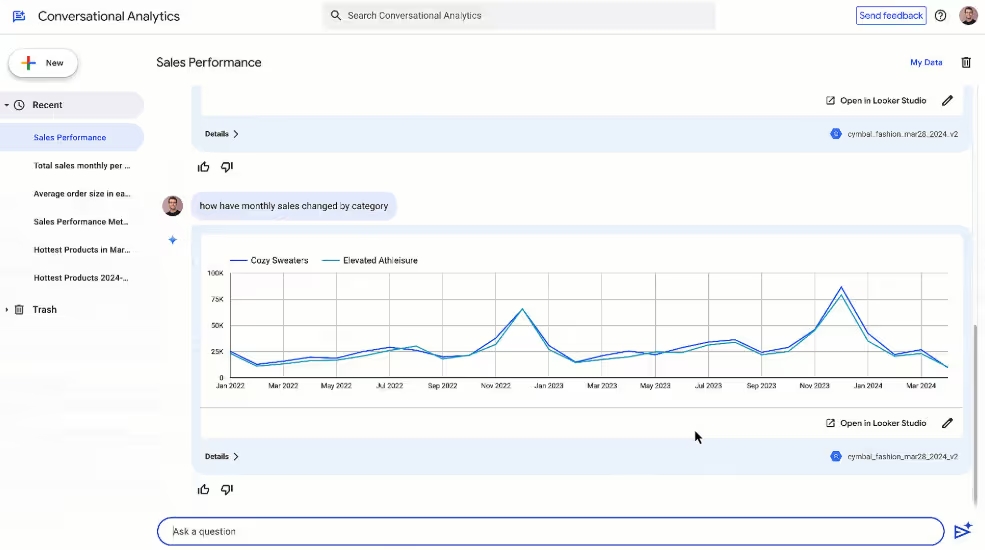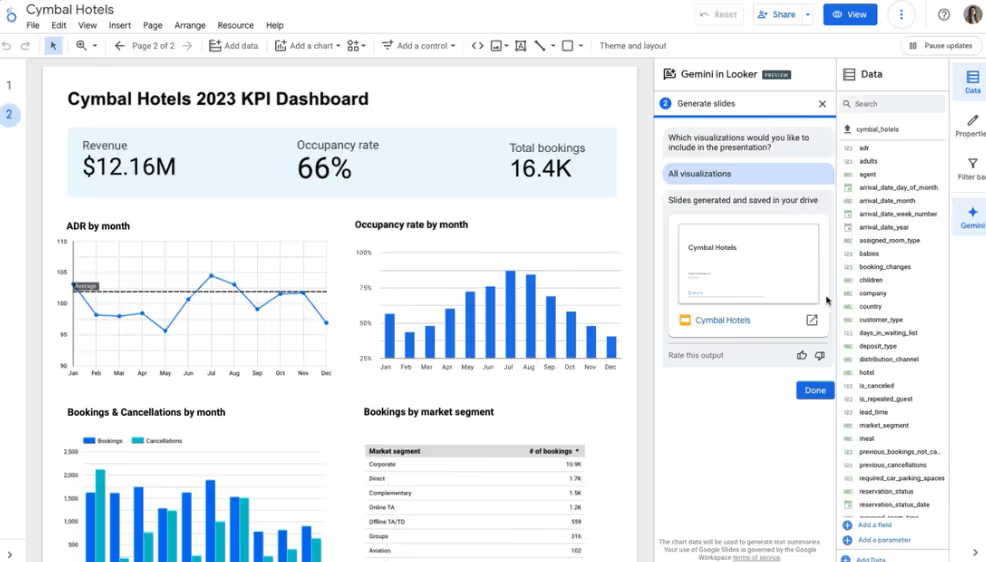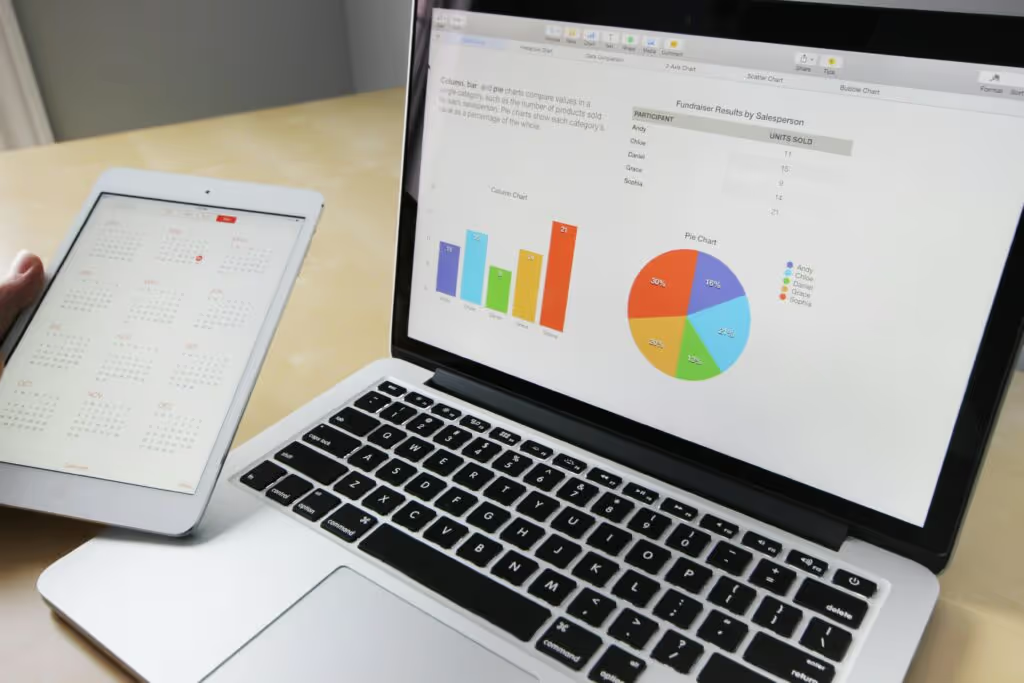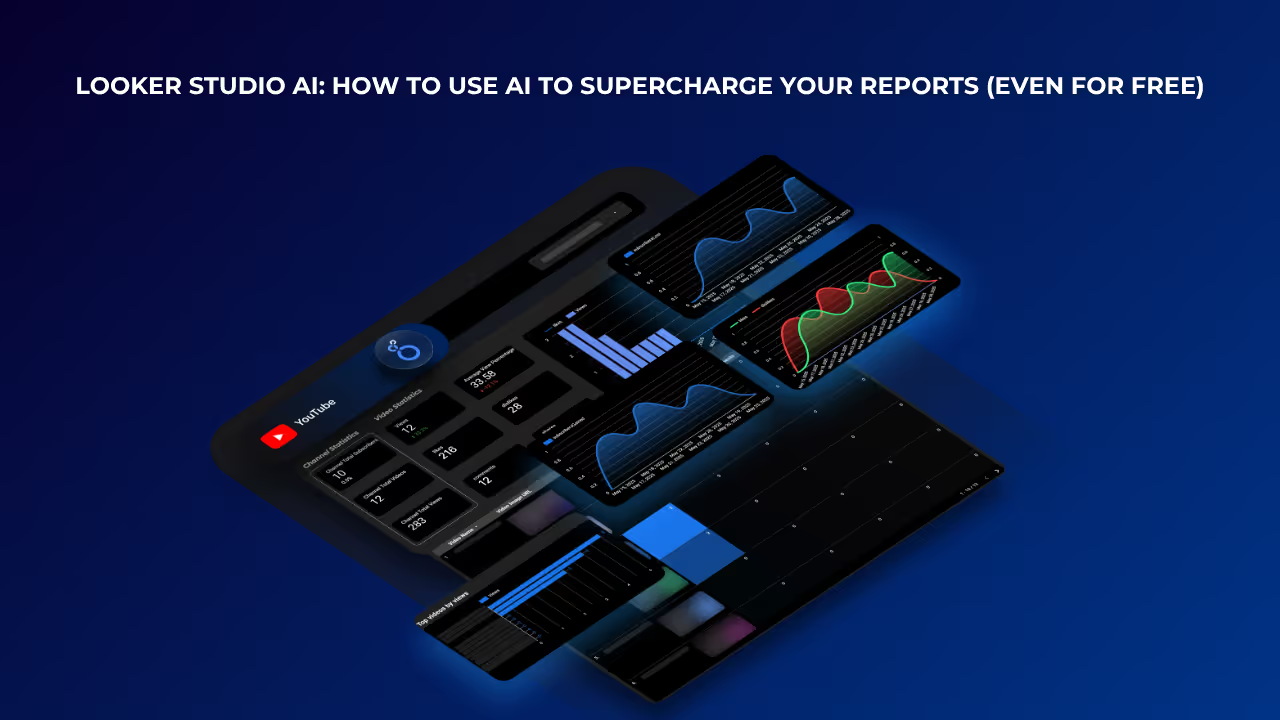If you’re working with reports in Looker Studio, you’ve probably heard that Gemini, Google Cloud’s generative AI, is now part of the Looker ecosystem. It’s currently available to Looker Studio Pro subscribers and is designed to make your life easier by offering conversational data analysis, smart formula suggestions, and even automatic text generation for reports.
It sounds great, and to be fair, it is. But it’s not available for users on the free version of Looker Studio. So, what can you do if you’re not on Pro?
In this post, I’ll walk you through what Looker Studio AI offers, why it’s so powerful, and, most importantly, how you can achieve similar AI-powered assistance using free tools and a bit of creativity.
What You Get with AI in Looker Studio Pro
The integration of Gemini with Looker Studio Pro brings some really helpful capabilities, especially for marketers who are constantly working with dashboards and reports. It's all about making everyday data tasks smoother and more intuitive by using Looker Studio AI to simplify complex processes.
Here’s what it offers:
1. Data Exploration with Natural Language
This feature allows you to interact with your data using natural language queries. You can type questions in plain English, like “What were our top-performing campaigns last quarter?”, and Looker will respond with relevant charts or tables. This means you don’t need to be a data expert or write complex queries to explore campaign performance or customer behavior, making data insights much more accessible.

2. Simplified Custom Metrics
If you need a specific metric that isn't readily available, Looker Studio AI can help you create calculated fields. You simply describe the metric you want in natural language, and it will suggest the appropriate formula based on your data. This takes the guesswork out of remembering functions for ad-hoc analysis and saves time, especially for marketers who aren’t spreadsheet experts.
3. Auto-Generated Report Drafts
With Looker Studio AI, you can generate an entire report, complete with visualizations, titles, and layout, just by providing a brief prompt. It gives you a solid starting point to build upon, significantly reducing the time needed to set up new reports from scratch.
4. Enhanced Data Storytelling
Beyond just presenting numbers, this integration helps you tell a more compelling story with your data. The AI can suggest relevant visualizations and even generate textual summaries that explain the insights shown in your charts, making your reports more impactful and easier for your audience to understand.
5. Data Literacy Support
By simplifying data through natural language, Looker Studio AI acts as an assistant that helps users better understand data, interpret visualizations, and ask more relevant questions. This can lead to a broader understanding of data within marketing teams, making it easier for non-technical users to engage with insights and make informed decisions.
6. Automated Presentation Creation
Another powerful feature of Looker Studio AI is the ability to create presentations directly from your Looker Studio dashboards. It doesn’t just export charts, it also adds insightful text summaries and highlights key findings for each visual, even across multiple pages of your dashboard. This can genuinely save you hours you’d normally spend copying visuals and writing explanations, freeing you up to focus more on strategy.

Gemini’s integration with Looker Studio was officially announced during Google Cloud Next '24 in April 2024. However, it’s important to clarify its current status: the AI-powered functionalities in Looker Studio, driven by Gemini, are still in a “preview” or pre-GA (General Availability) phase.
That means these features are accessible to users, specifically those with Looker Studio Pro subscriptions, but they are still under active development and not considered a fully launched, production-ready product. Some specific capabilities, such as slide generation and advanced calculated fields, are expected to become generally available later in 2025 through Looker Studio.
How to Get Similar Value Without Looker Studio AI
Even if you don’t have access to Looker Studio Pro, you can still use free AI tools, like ChatGPT Free, Google Gemini, or Claude, to enhance your reporting and extract similar value. These tools can assist you in analyzing data, suggesting formulas, summarizing trends, or even helping you write clearer report narratives.
For Marketers: From Numbers to Narratives
As a marketer, your job isn’t just to present numbers, it’s to turn data into narratives that resonate. Whether you’re analyzing a campaign, preparing a presentation deck, or crafting a slide for leadership, the way you frame your results matters just as much as the data itself.
That’s where generative AI can become your assistant, even if you’re not using Looker Studio’s built-in AI. Tools like ChatGPT can help you:
- Draft descriptions of campaign performance.
- Write summaries for dashboards.
- Suggest possible causes behind trends.
- Translate insights into messaging that resonates with stakeholders.
You don’t need Pro features to think and work like a data storyteller.
1. Upload a Visual and Get a Narrative
Say you’ve just finished a campaign performance report in Looker Studio. You’ve got the visuals, but you’re missing the story. Simply take a screenshot of your key chart or table, whether it’s a conversion funnel, spend vs. reach, or CTR over time, and upload it to a free AI assistant that supports image input.
Then ask things like:
- “What do you think I should highlight in a campaign review?”
- “Write a short narrative summary as if I were explaining this to my client.”
- “What’s the most important takeaway for my team?”
The AI won’t just describe the chart, it will help suggest where to focus attention. That helps clarify your message before you bring it into your presentation tool.
2. Raw Metrics, Request Framing
If your data lives in a spreadsheet, copy and paste a short table, week-by-week impressions, engagement rate, or ROAS, and ask:
- “Can you summarize this in three key points, including one area of concern?”
- “What would be three headline takeaways for a client presentation?”
- “Turn this into an executive summary with neutral, factual language.”
This way, you're getting help framing the message for the right audience. As a result, you’ll present more confidently and avoid last-minute rewrites.
3. Say It Better, Faster
Marketing often includes numbers that don’t tell the whole story on their own. Click-through rates, CPAs, or conversion rates might make sense to you, but they don’t always land well with your audience. AI can help rephrase technical metrics into punchy, human language:
- “Instead of saying ‘CPC dropped by 18%,’ how else could I say that?”
- “What’s a softer way to say ‘campaign underperformed’?”
- “Help me position this as a learning rather than a failure.”
These are the nuances that elevate a marketer from good to great, and when used thoughtfully, AI can be your personal sounding board.

4. Make the Data Work in Your Channels
Now that you’ve uncovered the insights, let AI help you adapt the tone for each platform. Try asking:
- “Write a short, engaging intro for this campaign data.”
- “Turn this insight into a LinkedIn post for our agency.”
- “Give me two tweet options using this chart as an image attachment.”
This is where AI goes beyond reporting, it becomes a creative partner, helping you translate data into your brand’s voice across different channels.
Why This Works
You just need a moment to pause and ask the right questions. AI becomes a strategic tool when you guide it well. And when you combine it with your own instinct for audience, tone, and message, it can help transform a static dashboard into a story that actually sticks.
Whether you’re reporting performance, pitching a concept, or closing the quarter, you’ve already done the hard part: you know the context. Let AI take care of the heavy lifting so you can focus on making your message matter.
For Analysts: Make AI Your Fast-Thinking Colleague
You already live and breathe the data, SQL tabs open, filters tweaked, spreadsheets everywhere. The challenge isn’t getting the numbers; it’s turning them into answers fast enough to keep projects moving. That’s where a free AI assistant can feel like an extra analyst who never sleeps.
Looker Studio AI can write calculated fields on the fly and respond to data queries in plain English. But a well-worded prompt in ChatGPT, Google Gemini (free tier), or Claude can deliver a similar productivity boost.
1. Quick Lines of Inquiry
You’ve exported weekly sessions, bounce rate, and conversions into a CSV. Before diving into pivot tables, paste a snippet into your AI tool and ask:
- “Given traffic, bounce rate, and conversions by week, what patterns or anomalies stand out? Suggest three angles for deeper analysis.”
The AI’s suggestions won’t replace your judgment, but they’ll surface ideas you might overlook, seasonal trends, post-launch dips, or segments worth isolating. Think of it as rapid exploratory brainstorming.
2. Decode and Refine Formulas
Calculated fields can pile up quickly, especially when a stakeholder wants a slightly different version of a metric. Drop a formula into the chat:
CASE WHEN Channel = 'Paid' THEN (Revenue - Cost) / Cost END
Then ask:
- “Explain this formula in plain English. Any simplifications or risks?”
The AI can describe its intent, flag redundant logic, or propose clearer syntax. That’s a quick lint check before you ship it into production.
3. Turn Charts Into Diagnostic Conversations
Screenshot a chart, a time-series spike, a scatter plot, a drop in conversions, and upload it. Then ask:
- “Spot any patterns or shifts worth noting?”
- “If you rebuilt this visual, what would you change and why?”
The response won’t critique aesthetics, but it may recommend binning data, smoothing the trend, or using a different chart type. This is especially useful when you’ve stared at a dashboard too long to see it with fresh eyes.
4. Stress-Test Your Own Conclusions
After drafting your insights, feed them back into the AI with a prompt like:
- “Here’s what I’m seeing from Q2 traffic. Play devil’s advocate, what counter-arguments or missing data points should I consider?”
You’ll get a quick list of blind spots, maybe a missing cohort view, the need for significance testing, or a potential anomaly in week 12, that sharpens your final report.

5. Iterate Under Tight Deadlines
In a late-stage crunch? AI can handle repetitive chores while you stay focused on strategy:
- Convert UTC timestamps to local time with a one-line suggestion.
- Draft regex for URL grouping instead of trial-and-error.
- Generate a sanity-check SQL query to replicate your Looker Explore output.
In short, it’s like having an infinite pair of extra hands when the deadline is brutal.
Why This Matters
The best analysts aren’t the ones who memorize every function, they’re the ones who ask sharper questions and validate answers quickly. A conversational AI assistant gives you:
- Velocity: More hypotheses per hour.
- Clarity: Fewer mystery formulas in your model.
- Bias checks: A mirror for your assumptions.
- Time reclaimed: Delegate tweaks to a tireless assistant.
Used thoughtfully, free AI tools don’t replace your methodology, they reduce cognitive clutter so you can think bigger, faster. Your expertise is the engine. AI just helps you shift into a higher gear.
For Decision-Makers: Cut Through the Noise and Focus on What Matters
You don’t need to understand every chart, filter, or calculated field. What you do need is clarity: what’s working, what’s not, and what deserves your attention right now.
Looker Studio AI was built with you in mind. It enables natural-language querying and generates quick summaries of complex reports. But here’s the good news: even if you’re not using the paid version, you can get remarkably close with free AI tools.
It’s like having a chief of staff who reads fast and asks the right questions.
1. Skip the Raw Data, Let AI Frame the Story
If your team sends you a weekly or monthly report in Looker Studio, chances are you get either a link, a PDF, or a screenshot of the key charts. Instead of scanning and guessing where to focus, drop that content into a free AI assistant and ask:
- “Summarize this in three points for a leadership meeting.”
- “Highlight anything unexpected, positive or negative.”
- “What questions should I ask the team based on this?”
In under a minute, you’ll get an executive-friendly digest that highlights not just what’s in the data, but why it matters. This is especially helpful when you’re overseeing multiple teams and need to skim across product, marketing, and operations quickly.
2. Got a Full PDF Report? Let AI Do the Read
Drop the PDF into an AI assistant and ask for a high-level overview. Try prompts like:
- “What’s the big picture here? Where are we doing well, and what’s off track?”
- “Flag anything that could become a risk if ignored.”
- “Write a summary I can use for our next board prep.”
The AI doesn’t just scan, it synthesizes. It reads trends, interprets language, and draws out implications, giving you the clarity to walk into any meeting ready to lead with confidence.

3. AI Helps You Ask Better Questions
One of the most underrated benefits of AI at the leadership level is how it sharpens your inquiry.
Feed it a report and ask:
- “If you were me, what would you want clarified by the analytics lead?”
- “What’s missing here that I should push back on?”
- “Are the conclusions in this report fully supported by the data?”
You’ll often get follow-up questions you wouldn’t have thought to ask. This isn’t about replacing your intuition, it’s about reinforcing it with a second, objective lens.
Why This Matters
In today’s decision cycle, speed and clarity are everything. You don’t need more data, you need better context. Free AI tools help you:
- Save time scanning through dashboards
- Get to the “so what?” faster
- Prepare smarter for meetings and check-ins
- See around corners by spotting early warning signs
You don’t need to configure anything, write code, or understand SQL. You just need to ask the right question, in plain language, and let the assistant do the rest.
Final Takeaway: Looker Studio AI or Not, AI Is Already on Your Team
If your team has access to Looker Studio Pro, Gemini is now integrated directly into every stage of the workflow, handy, seamless, and undeniably fast.
But the absence of Looker Studio AI doesn’t lock you out of modern, AI-driven analytics. A screenshot, a copied metrics table, or a PDF dropped into a free AI assistant can deliver meaningful value, whether you’re building a marketing narrative, testing an analyst’s hypothesis, or reviewing a deck before a board meeting.
With nothing more than the right prompts, you can:
- Surface patterns you might have missed
- Turn raw data into clear narratives
- Double-check (or simplify) complex formulas
- Crowd-source follow-up questions, without crowding your team’s calendar
Your datasets stay under your control; AI simply shines a smarter light on them.
But before AI can work its magic, make sure your data flows into Looker Studio smoothly and reliably. Dataslayer’s connectors make it effortless to pull data from Google Ads, Facebook, TikTok, and other platforms, so your dashboards stay updated and your analysis stays focused.
So, put the free tools you already have to work today. If later you decide that Gemini’s native integration is worth the upgrade, you’ll be choosing it from a position of clarity, knowing exactly which pain points it solves, and which workflows you’ve already mastered on your own.







